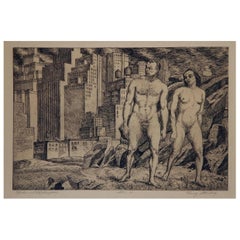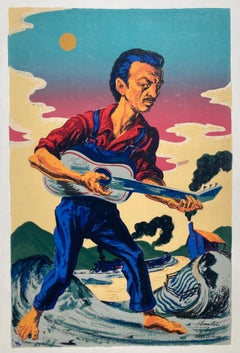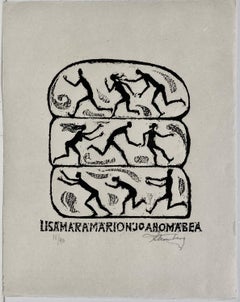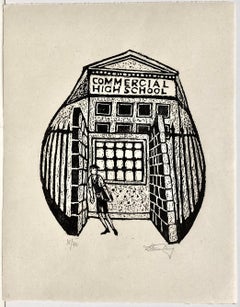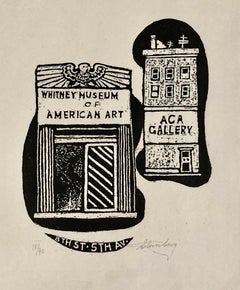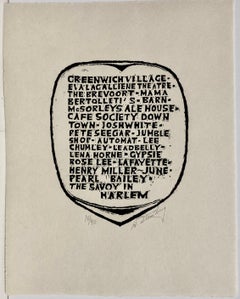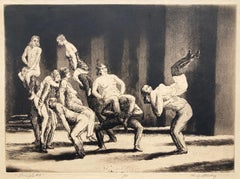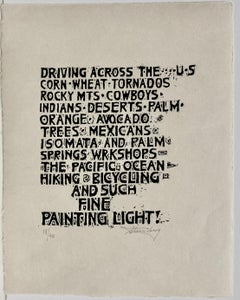Harry Sternberg Figurative Prints
Harry Sternberg was an American painter, printmaker, muralist, lithographer and educator. He was born in New York City on July 19, 1904. He studied at the Art Students League of New York, graphics with Harry Wickey. During the Depression, he was a Works Progress Administration artist and his murals are in post offices in Chicago as well as Chester and Sellersville, Pennsylvania. In 1936, Sternberg was awarded a Guggenheim Fellowship for creating a series of drawings, prints and paintings showing the principal American Industrial and agricultural occupations. He confined his investigations to the coal and steel industries of eastern Pennsylvania, immersing himself for several months in the lives of the coal miners in Mahanoy City. When he returned to New York, he made a series of 11 prints that emphasized the bleak lives and dangerous work of the miners. Sternberg wished to point out the dangers of working in the mines, the diseases caused by the inhalation of coal dust, mine collapses and maiming dynamite accidents that would result in such mutilations. From 1934–68, he taught painting and graphics at the Art Students League of New York, from 1942–45, graphics at the New School for Social Research and 1959–69, he was the head of the Art Department in the Idyllwild School of Music and Art at the University of Southern California. He wrote several books on graphics including silk screening, etching and woodcutting. Sternberg died on November 27, 2001, in Escondido, California.
Mid-20th Century Harry Sternberg Figurative Prints
Paper
1940s American Modern Harry Sternberg Figurative Prints
Screen
1990s American Modern Harry Sternberg Figurative Prints
Woodcut
1990s American Modern Harry Sternberg Figurative Prints
Woodcut
1990s American Modern Harry Sternberg Figurative Prints
Woodcut
1990s American Modern Harry Sternberg Figurative Prints
Woodcut
1990s American Modern Harry Sternberg Figurative Prints
Woodcut
1970s American Modern Harry Sternberg Figurative Prints
Screen
1980s American Modern Harry Sternberg Figurative Prints
Screen
Mid-20th Century Harry Sternberg Figurative Prints
Paper
1990s American Modern Harry Sternberg Figurative Prints
Giclée, Screen
Early 1900s Vienna Secession Harry Sternberg Figurative Prints
Paper
1940s American Modern Harry Sternberg Figurative Prints
Screen
Mid-20th Century Modern Harry Sternberg Figurative Prints
Paper
1940s American Modern Harry Sternberg Figurative Prints
Lithograph
1970s American Modern Harry Sternberg Figurative Prints
Screen
Late 20th Century American Modern Harry Sternberg Figurative Prints
Offset
Mid-20th Century Modern Harry Sternberg Figurative Prints
Paper
1950s American Modern Harry Sternberg Figurative Prints
Offset
1930s Realist Harry Sternberg Figurative Prints
Etching, Aquatint
1990s American Modern Harry Sternberg Figurative Prints
Woodcut
1990s American Modern Harry Sternberg Figurative Prints
Woodcut
1990s American Modern Harry Sternberg Figurative Prints
Woodcut
1990s American Modern Harry Sternberg Figurative Prints
Woodcut
1990s American Modern Harry Sternberg Figurative Prints
Woodcut
1940s American Modern Harry Sternberg Figurative Prints
Aquatint
1940s American Modern Harry Sternberg Figurative Prints
Screen
